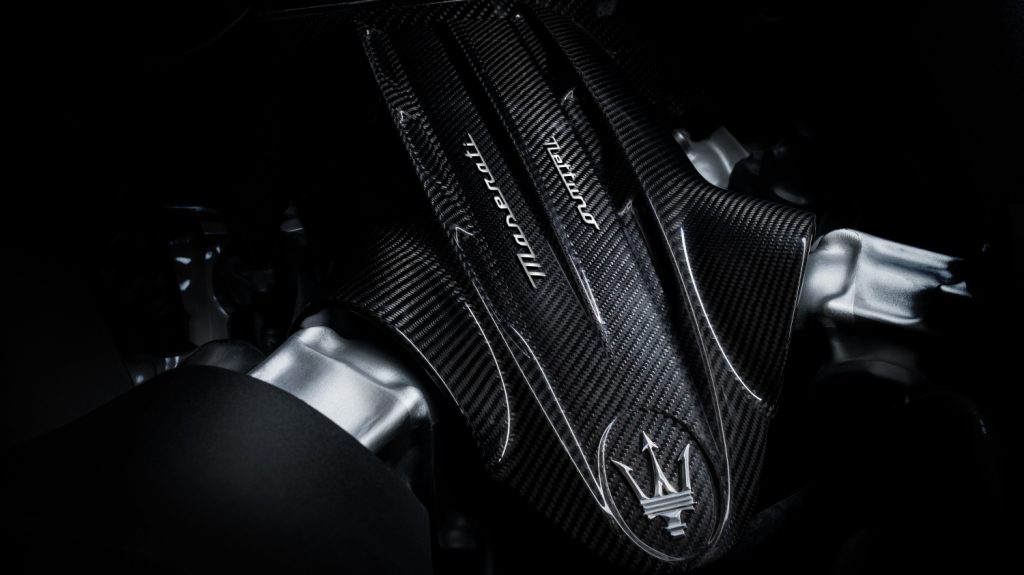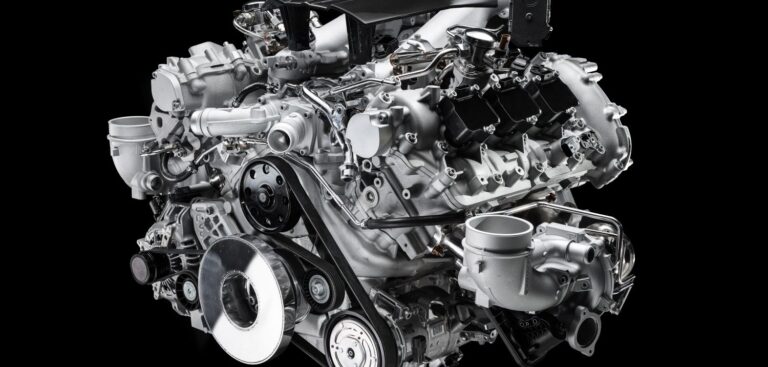Following the launch of the Maserati MC20 last week, which sports the company’s pre-chamber ignition-equipped Nettuno V6 engine, the company’s head of powertrain innovation, Ettore Musu, explains some the key development challenges.
This project was born early in 2015 in a very specific context, because we were just starting the Giorgio project, intended to relaunch Alfa Romeo and Maserati. From the outset, the team delivered a motivation and passion that spread to everyone working on the project. In this context, thanks to the enthusiasm and passion of the people involved, the idea arose of not just settling for something that equaled others, but of creating something special, something extraordinary.
The inspiration came from the racing world, where this system, a kind of insert, was placed between the spark plug and the combustion chamber. We wondered whether we could also use this item in a standard production engine. We began to think about it. Initially it was a secret project within the Giorgio project. I remember that at the beginning there were two or three of us working on it – one person doing the calculations, one designing and me trying to coordinate things a little. We managed to go ahead, to design some objects and to start testing them around September/October 2015.
The benefit of this technology was clear at once, from the very first trials. We immediately noted that it brought benefits, especially when the engine was at very high power outputs. At the same time, we realized the system had drawbacks: the engine was very unstable in the phases generally considered normal operation on a road car, meaning when traveling at low speeds with the engine delivering only low power levels. There were great benefits at high power outputs, but major problems at low powers. So we had to study how to use this concept to make it feasible for application on a road car.
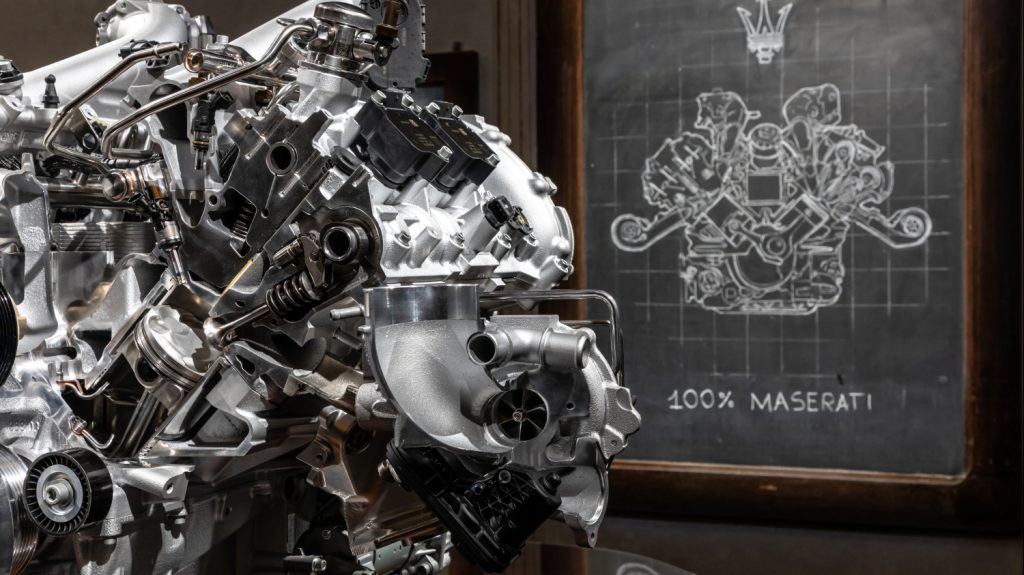 The benefit is more efficient use of the energy contained in the fuel. Basically, the engine’s efficiency is increased and higher power outputs are achieved, not because more petrol and more air are taken in, but because the air and petrol we already have available are used better. The next step is to add a second spark plug in the main combustion chamber. This may seem fairly obvious, but we had to understand how these two objects work together and decide the control strategies to enable them to operate so that the two combustion systems could function in tandem, because in the final analysis, the engine has two combustion systems: a conventional combustion system and an innovative combustion system. They have to be controlled and operated together, so that the transition between the two operating modes is imperceptible. This led to the patent, issued to protect these strategies and enable a pre-chamber to operate on a standard production engine.
The benefit is more efficient use of the energy contained in the fuel. Basically, the engine’s efficiency is increased and higher power outputs are achieved, not because more petrol and more air are taken in, but because the air and petrol we already have available are used better. The next step is to add a second spark plug in the main combustion chamber. This may seem fairly obvious, but we had to understand how these two objects work together and decide the control strategies to enable them to operate so that the two combustion systems could function in tandem, because in the final analysis, the engine has two combustion systems: a conventional combustion system and an innovative combustion system. They have to be controlled and operated together, so that the transition between the two operating modes is imperceptible. This led to the patent, issued to protect these strategies and enable a pre-chamber to operate on a standard production engine.
The pre-chamber isn’t a new idea. There are patents covering a concept of this kind dating from the early twentieth century. It was used in a few prototypes, there are various patents around, but then a lot of people gave up on it. I’ve also seen a considerable number of patents from the past, but it seems people never managed to overcome all the problems posed by this object. It may seem obvious, but we were also faced with a mass of problems to be overcome.
We worked on this concept for four years before obtaining approval of the program to enable it to be used in production; we had to resolve every anomaly and problem that emerged from the introduction of this design, one by one. First of all, the increase in performances, because an increase in performances means increasing pressures and increasing thermal stresses, so we had to completely redesign an engine to enable it to withstand a performance level that was unknown even to us. At the start of the project, even we didn’t think it would be possible to achieve such a high performance level.
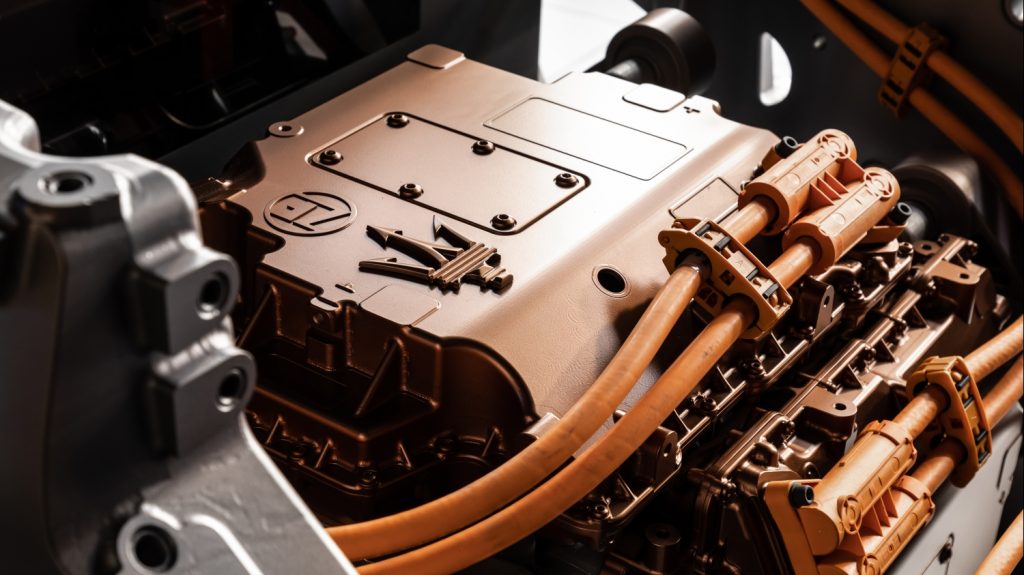 One important step in the project’s development was the idea of the Twin Spark combustion system and then the construction of the demo car. In mid-2017 we started to transfer this engine to a car, and we realized we’d have to bear in mind other issues during the development: emissions, onboard diagnosis (OBD) compliance, vibrations, and then all the structural problems. From 2017 onward, most of the team was working on resolving all the engine’s anomalies in these areas. It was very difficult to define the design of the piston and all the engine’s structural parts, to enable them to withstand a level of performances far above anything we’d known before.
One important step in the project’s development was the idea of the Twin Spark combustion system and then the construction of the demo car. In mid-2017 we started to transfer this engine to a car, and we realized we’d have to bear in mind other issues during the development: emissions, onboard diagnosis (OBD) compliance, vibrations, and then all the structural problems. From 2017 onward, most of the team was working on resolving all the engine’s anomalies in these areas. It was very difficult to define the design of the piston and all the engine’s structural parts, to enable them to withstand a level of performances far above anything we’d known before.
A couple of factors were crucial in changing the results: the first of these was the choice of material. We used a copper alloy, a material that tends to disperse heat rapidly, with very high thermal conductivity. This was one of the first things that gave us decent results from the outset, and I must say that we’d come up with this choice of material more or less right from the start, because we’d realized that the thermal stress being generated on this object would be very high and even the initial calculations and simulations told us that we had to get rid of a lot of heat from this object, which is also immersed in the engine’s cooling water, meaning that the water flowing between the head and the top of the head, the flame plate, also cools this object. I believe this was a very important idea, because it enabled us to cool this object correctly; otherwise, we’d never have achieved the results we have achieved, because of the temperatures generated in an object which basically only does combustion.
It’s not like a conventional combustion chamber that also receives cool air; the intake valves open and feed a lower temperature into the charge. This object only receives hot gases, so the temperatures are very high. This was the first insight that helped to change the overall outcome. Next came another important point concerning the choice of spark plug: initially, performances were limited because the spark plug was unable to offer anything more, but then, among our various tests, we managed to invent or test a spark plug compatible with combustion inside this object: a spark plug which, like the pre-chamber, was also able to disperse a large amount of heat.
The final fundamental idea was to use the Twin Spark system, because with the second spark plug we can make the engine function conventionally in operating modes with low power outputs. We have a pre-chamber for each cylinder and then a second spark plug for each cylinder, making this a Twin Spark system. For each cylinder, we have one spark plug in the pre-chamber and one serving the main combustion chamber, giving us a total of 12 plugs and six pre-chambers.
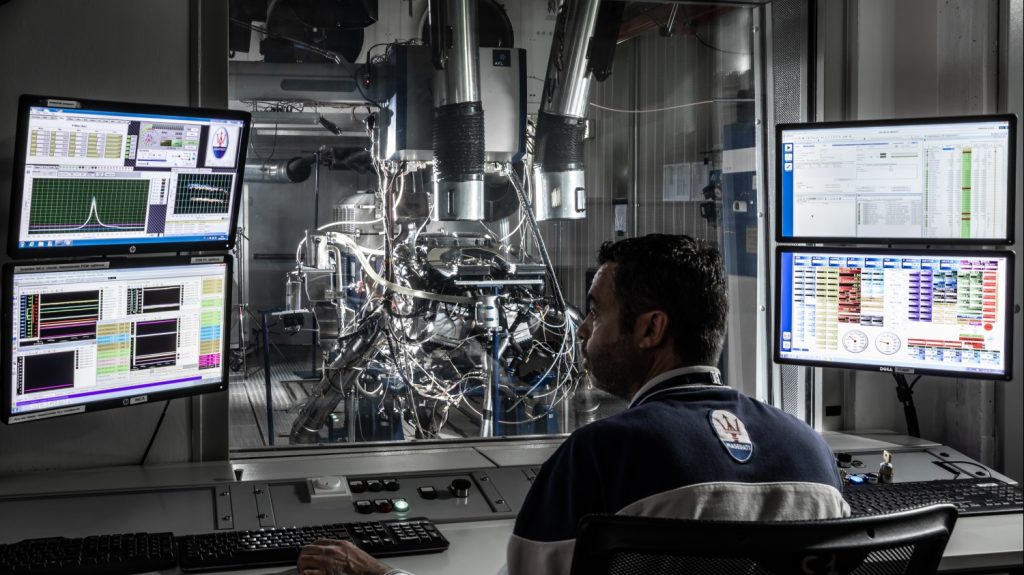 The great thing about this combustion concept is that it enables us to increase performances while simultaneously improving the engine’s fuel efficiency. This is one of the system’s strong points. Naturally, this implies an increase in cost, because we need six extra spark plugs on six cylinders, six extra coils to activate the plug, more wiring, and component numbers that increase in one way or another. Then this object is in a fairly expensive material: €8 is quite a lot for a piece of metal, and overall this means an additional cost of about €150 for a six-cylinder engine.
The great thing about this combustion concept is that it enables us to increase performances while simultaneously improving the engine’s fuel efficiency. This is one of the system’s strong points. Naturally, this implies an increase in cost, because we need six extra spark plugs on six cylinders, six extra coils to activate the plug, more wiring, and component numbers that increase in one way or another. Then this object is in a fairly expensive material: €8 is quite a lot for a piece of metal, and overall this means an additional cost of about €150 for a six-cylinder engine.
The substantial benefit of this object is that it delivers both a significant improvement in performance and a reduction in fuel use. In terms of the performances of a V6 engine, power output is increased by about 120/130bhp and torque by about 130Nm. In general, with an internal combustion engine there’s always a trade-off, meaning that engines required to deliver higher performances inevitably also consume more fuel. In this case, the trade-off is moved to a higher level, so it’s possible to achieve higher performances and also reduce fuel use, simultaneously. With the same contents, we’ve found that this technology provides a potential reduction in fuel use of about 3%, which we’ll be introducing on our Maserati cars.
The really exciting thing is that everyone who has tested this technology has been really impressed by it. The most striking things are above all the performances and the car’s sound, which is different from a conventional engine. Lots of executives fell in love with it at first sight, and immediately decided to sponsor the continuation of all the pre-development activities, including the finalization of the technology for real production.
It’s difficult to assess feeling or emotional benefits just from a power curve. If I show you a power curve and you see 130hp more, it’s difficult to translate that into the emotion or sensation actually experienced. Those who’ve had the chance to test drive the demo car have been able to appreciate how this additional performance raises emotions, sensations and experience to a higher plane. And this was a very important step in the timeline of this technology’s development.
We know we’ve done something extraordinary. I believe that in the future this technology will be widely adopted, even by competitors, but being the first, in a sector as competitive as the automotive world, is definitely a source of great satisfaction. What makes us all proud is having worked on the design of such a revolutionary engine at the time when we’ve turned our back on Ferrari engines to construct our own engines. A transition that defines an era, really. However, we’re confident that what we can come up with in-house can be superior to what other people were able to offer us.
